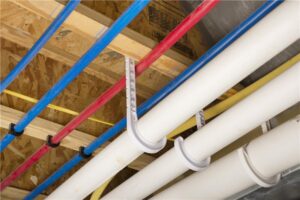What Is PEX Plumbing?
 PEX plumbing uses flexible cross‑linked polyethylene tubing instead of rigid metal or PVC. This flexible plumbing pipe bends around corners and weaves through walls without extra fittings.
PEX plumbing uses flexible cross‑linked polyethylene tubing instead of rigid metal or PVC. This flexible plumbing pipe bends around corners and weaves through walls without extra fittings.
At Len The Plumber Heating & Air, we’ve helped homeowners switch to PEX for faster installs and fewer leaks. Read on to discover how PEX differs from copper and other types of pipes, its pros and cons, and when it makes sense for your home.
Understanding PEX Plumbing Basics
PEX stands for cross‑linked polyethylene. In simple terms, manufacturers treat ordinary polyethylene under heat or radiation to create bonds between its plastic molecules. This process gives PEX its strength, flexibility, and resistance to heat. PEX tubing arrived in Europe decades ago and reached U.S. homes in the 1980s. Back then, plumbers used copper or rigid PVC, which required soldering or solvent welding at every joint.
PEX changed the game by letting installers use crimp rings or push‑fit connectors instead. Unlike metal pipes, PEX won’t corrode, and it won’t burst if water freezes inside. It meets all modern plumbing codes and offers a friendly way to deliver water to kitchens, bathrooms, and laundry rooms.
Types of PEX Pipes and Their Applications
There are three main PEX pipe types:
- PEX‑A uses the Engel method and offers the most flexibility, which helps it bounce back after a freeze. It often serves as radiant‑floor heating loops in homes because it can handle repeated expansion.
- PEX‑B uses the silane method, making it slightly stiffer. However, it’s easier to bend than metal. PEX-B works well for kitchen and bathroom water lines.
- PEX‑C is made by irradiating finished tubing; it offers a middle ground in flexibility and cost. It also works well for kitchen and bathroom water lines.
You’ll spot red PEX for hot water, blue for cold, and white for general use. Swapping among these types helps plumbers match performance with budget on each job.
Key Benefits of PEX Plumbing
When weighing PEX plumbing pros and cons, the advantages often stand out first:
- The flexibility of PEX piping slashes labor time because you need fewer joints and fittings. A single length of PEX can snake from the basement to the bathrooms without extra couplings. That saves on both parts and plumber hours.
- PEX costs less than copper and won’t be affected by fluctuating metal prices.
- PEX resists corrosion and mineral buildup inside the pipe so you won’t lose flow over the years.
- PEX can stretch slightly if water freezes, which cuts down on burst‑pipe emergencies.
All these perks add up to lower installation costs, fewer repairs, and better performance in both hot and cold climates.
Common Concerns & Limitations
Every material has drawbacks, and PEX is no exception.
- PEX is sensitive to UV light, and prolonged sun exposure can weaken the tubing. That means you shouldn’t run PEX outdoors unless it’s sheathed in UV‑resistant conduit.
- Mice and rats sometimes chew plastic, so PEX piping is at greater risk of rodent damage. Always protect exposed runs in crawlspaces or attics.
- Not every municipality accepts PEX yet, so you’ll need to check local plumbing codes and insurance rules before installing it.
Despite these hiccups, PEX remains one of the most versatile and cost‑effective options in modern residential plumbing.
PEX vs Copper vs PVC: Which Should You Choose?
When comparing PEX vs copper vs PVC, balance factors like durability, cost, and maintenance.
Copper lasts for decades and resists UV, but it can corrode in acidic water and costs two to three times more than PEX. PVC is cheap and rigid, good for drains, but brittle in cold weather. PEX sits in the sweet spot: it’s durable, flexible, and mid‑priced.
Pipe repairs for PEX are simple; you cut out the bad section and crimp on a new fitting. Copper repairs demand soldering, and PVC needs solvent welding.
For a whole‑house repipe or new construction, PEX often wins by saving money on parts and labor, while still delivering reliable performance.
Why Should You Choose Len The Plumber Heating & Air?
You’ve learned what PEX plumbing offers: bendable tubing, fewer leaks, and big savings on installation. Len The Plumber Heating & Air has over 25 years of experience working with cross‑linked polyethylene and all other piping materials.
Our plumbers stay up to date on the latest PEX pipe installation methods and local code requirements. Whether you need a simple kitchen repipe, a radiant‑heat upgrade, or a whole‑house repiping project, we bring craftsmanship and honesty to every job.
If you are ready to switch to PEX or explore other plumbing solutions, contact Len The Plumber Heating & Air today and keep your water flowing seamlessly. We serve Baltimore, Washington, D.C., Northern Virginia, New Jersey, Pennsylvania, and the Delaware Valley.
From Len The Plumber Heating & Air
 Coupons
Coupons 

